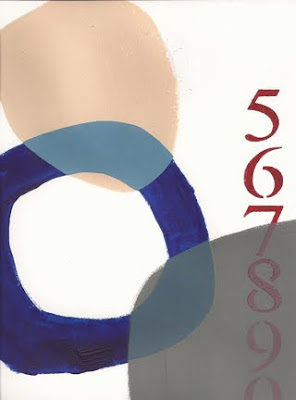For this fifth lesson in Jane Davies' advanced colour class, we looked at the way colours interact.
Have you ever had the experience of trying to determine whether that jacket is black or dark navy? One approach is to compare it to something you know to be black. The contrast with black can help you see if there's a difference.
Below, as part of this week's assignment, are three examples where I paired a fully-saturated background with a lighter background made from a tint of that same colour. The small squares are actually the same colour, left and right, but they look a little different depending on their background.
When I squint, I can see that the small square on the less-saturated background appears more saturated than its mate. The strength of this effect seems to depend on the difference in saturation between the two larger squares. Or the phenomenon could be described in terms of value: the small square looks darker against a light background, and lighter against a dark background.
I'm finding the results of these "temperature experiments", below, barely perceptible.
Above, a neutral grey set on a warm orange and a relatively cool green. The grey on the right might have a subtly warmer cast, because it contrasts with the coolness of the green.
Next, a slight variation, using a different neutral and warm and cool backgrounds. The same effect holds.
Another variation, with an icy cool turquoise to replace the yellow-green. The effect is still barely noticeable, at least to me.
So then I started to wonder whether, if I used small squares with more saturated colour, the warm/cool effect would be stronger.
And I think that's true: the small violet square on the right (cool background) seems a bit warmer or redder than the one on the left (warm background) which seems cooler or bluer.
And here the orange square appears warmer or redder on the right (cool background) a little more yellow (paler, lighter) against the warm background on the left.
And perhaps the most obvious result here, with the small magenta square redder (warmer) against the cool turquoise background and bluer (cooler) against the warm orange background.
So I would propose that the more saturated the small squares, the more evident the temperature shift against warm vs. cool backgrounds. And the bigger the difference in temperature in the background squares, the more obvious the effect.
Still with me?
Having made about 80 painted swatches for the above experiments, we were asked to find exciting mixes using just three colours. We were to make little 3" collages, not paying attention to composition but just to look for a trio of colours that play well together. Below are some fun examples that I cobbled together. Our instructions were that the third colour was to be used in a smaller quantity, as an accent.
Submitting these trios wasn't enough, though. We were asked to explain just what it was that we found intriguing about our colour combinations. If they have some "zip", why?
 |
| #1 - Pyrrole Red / Quin Red / Manganese Blue + Diox Purple |
 |
| #2 - Pyrrole Orange / Quin Red / Pyrrole Orange + Cad Yellow |
 |
| #3 - Pyrrole Red / Quin Red / Pyrrole Orange + Cad Yellow |
For #2 and #3, I said that it was intriguing that red-violet is on the border between warm and cool colours. Technically, it's warm, but when paired with a true red or an orange, it is relatively cool.
 |
| #4 - Quin Red / Raw Umber / Green Gold |
 |
| #5 - Chartreuse / Pyrrole Red / Quin Red |
# 4 and #5 involve the pairing of chartreuse and red-violet, which are complementaries. Both are on the borderline of warm and cool. In #4 the dissonance between them is buffered by the neutral taupe, but in #5 the red-violet is supported by the pure red, and I find both interesting.
 |
| #6 - Cobalt Teal / Chartreuse / Mang Blue + Diox Purple |
Is the chartreuse in #6 warm or cool? Technically it's a cool colour, but paired with cooler blues, it appears to be warm.
 |
| #7 - Hansa Yellow / Graphite Gray / Light Graphite Gray |
#7 is a showcase for the pure, bright Hansa Yellow, with its intensity heightened when paired with neutral grays.
 |
| #8 - Raw Umber / Graphite Gray / Diox Purple |
And in #8, there is very little "chroma" in the neutral gray and taupe. There is chroma in the purple, but it is almost too dark to be seen. So that makes it interesting too.
We're going to use our little samples to make colour-field paintings in Lesson #6. It will be intriguing to see what combinations the other class participants come up with.

















































